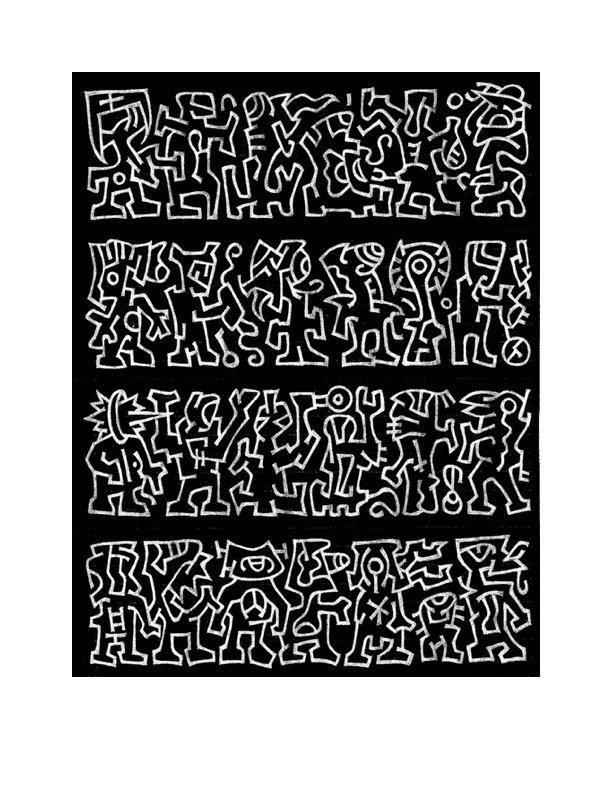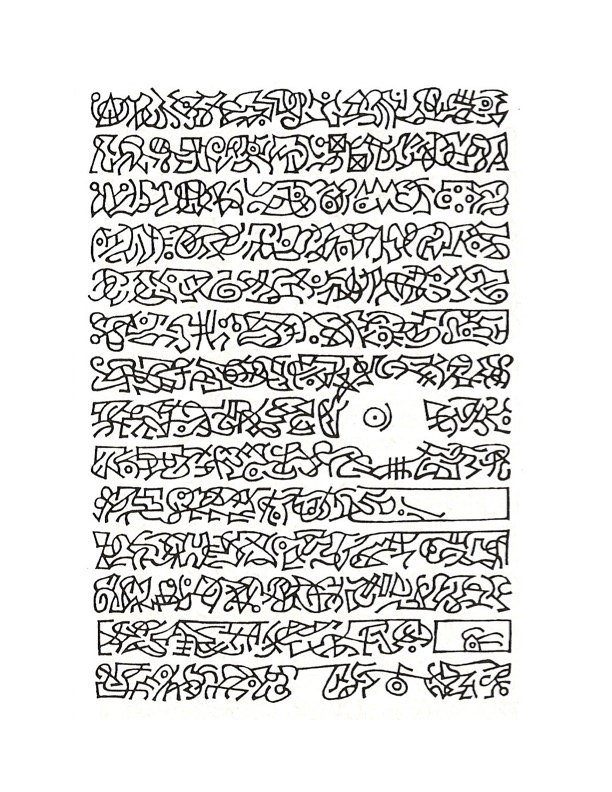What inspires you to create asemic writing?
MJ: I am inspired by the grand design and minute details of the Universe. When I was young I was a pen pal with an Astronaut and was heavily influenced by comic books (X-Men, Rom, etc.) 1970s & 80s TV, Sci-Fi (Star Trek & Star Wars), Atari, and Dungeons & Dragons. But I also felt like a nomadic nature worshiper too. I was raised as a Lutheran but felt more connected to the natural environment than the rigidness of the church. I still celebrate X-Mas but am mostly secular but with a healthy amount of superstition and spirituality; I consider myself to be an Agnostic-Pantheist. I got my start through observation of the world around me, and just simply absorbing it in and exhaling out my own interpretation. I collected all of these experiences and added them to my asemic writing which came later on in my 20s, and I am 48 now. I am also inspired by artists, writers, and extraordinary people and their complex interactions with ordinary life; I like to find the “alien” in my everyday experience. I wrote my first abstract calligraphic book The Giant’s Fence in a time of death and uncertainty, and it helped me to carry on through life even though I, at times, have felt spiritually dead. TGF was first published as a chapbook in 2001, but I started writing it in 1999. It is probably my most intense work and is available as a free download at UbuWeb in the visual poetry section or as the first part of my book Works & Interviews.
What inspired you to establish Post-Asemic Press?
MJ: I started Post-Asemic Press because I had experience with self-publishing from creating my book Works & Interviews, which is a collection of my asemic writing and 8 interviews I gave on the topic to various online publications. My friend, the poet and film scholar Spencer Selby, was having trouble shopping his book Unknown Message around, and he couldn’t find a publisher for his glitch asemics. Since I was updating my W&I book anyway, I decided to start a small press and publish his book too. My friend Tim Gaze started a small press called Asemic Editions in 2011, but he only published 5 books and then stopped. Tim is extremely influential to me especially with his early championing of asemic writing through his activism with Asemic Magazine. So he inspired me to start the press. Two other works that I published to round out the first year’s book publishing at PAP were Rosaire Appel’s wonderful collection Zinc Zanc Zunc: An Asemic Conjugation, and Volodymyr Bilyk’s visually complex book Codex Abyssus. So far I have published 16 books. Number 14 is Tim Gaze’s book Glyphs of Uncertain Meaning which is available now through online bookstores. It is a collection of older asemic works of Tim’s stretching out from 1998 - 2008, and is a very primal display of original writing, somewhat similar to Chinese oracle bone scripts or proto-writing but modernised for the Internet age.
In 2017 I organized Post-Asemic Press into a book publishing project with only a little knowledge of what to do as far as running a press goes. I am fortunate to have many contacts in the art and poetry communities from running my blog gallery The New Post-Literate and these contacts assisted me with getting the press off the ground especially since I survive off of disability (for schizoaffective disorder) and don’t have a lot of access to funds. The press currently breaks even as far as money goes; I am deeply grateful for all the fans of the press who helped it get off the ground. The press works through print-on-demand technology, so I don’t need much as far as an office goes, I just have a desk, a computer, and a cardboard box. Even though books are a hard sell these days, I think it is still an exciting time to be a book publisher. All of this technology has made asemic writing very dynamic, and I am just glad to be along for the ride.
What is the one thing you would like readers to take away from your work?
MJ: Through my asemics I have found myself in a meditative state of being content with the chaos of the world. My asemics reflect this chaos but they are also orderly in a crop like formation. I like to pay homage to lines in my work because I am still partly a traditionalist with respect to how information is organized. So in a great many of my asemic works there are lines of an endless shape and variety. I’m also only one generation off the farm on my mother’s side and that is something I have kept, an agricultural mid-western approach to nonverbal calligraphic expression. My asemics look alien, but the aliens seem to like to abduct rural folk more than us city dwellers anyway, probably because there are less witnesses. Some crop circles could pass for asemic writing too! The main thing I want people to take away from the work is enjoyment and inspiration. Even though my asemic writing is illegible I hope it comes across as interesting, enlightening, and even entertaining.
From the books?
MJ: My recent work is poetry. I have a collection of autobiographical senryu/haiku poems titled Hei Kuu, which means Hello Moon in Finnish and is also a play on the word haiku, that came out in October of 2020. Hei Kuu was written when I was still drinking and edited when I sobered up (since June of 2020). In the book I spilled the good, bad, and ugly parts of my life and utilized the senryu poetry form because it just clicked with me, and out gushed my life onto the page like a new baby being born. Senryu are similar to haiku but are focused on the human condition instead of on nature, but like anything, the lines are blurry. I also have a prose poetry novella titled Somnolent Game coming out next year (2022) from Post-Asemic Press. Somnolent Game is about a bot maniac who has achieved sentience due to someone else's memories and he is trying to escape violence even though that is what he is programmed to do. He needs to create one true personal story so he can escape the wasteland and find a new life as a clone in paradise. The book is written in a quick stream-of-consciousness style for most of the book with a top secret ending. I’m still editing it, but I am almost done. It will come out in April of 2022. I am also starting to paint, with gouache, a colorful novella length book of asemic writing titled id est: neo scribalist asemic expressionism. It is slated to come out on my 50th birthday in 2023. The title id est means “that is” in Latin. I learned some Latin years ago to help me quit smoking cigarettes. The book takes and modernizes and revives the role of the scribe and gives a new purpose of expression. It is a pantheistic manuscript because I believe that the concept of God is too large for any one specific religion and my book tries to reflect this point.
As far as book publishing goes, I want to expand my publishing beyond mainly asemic writing to include the occasional work of experimental poetry thrown in to keep things lively. There are a lot of great books brewing at Post-Asemic Press. In 2021 I published Tim Gaze’s Glyphs of Uncertain Meaning, Laura Ortiz’s abstract graphic design masterpiece Unwritings, and Karl Kempton’s visual poetry collection intimate h&s. In 2022 I have 5 books coming out from Mike Di Tommaso (l’nguajamm’r), myself (Somnolent Game), Grzegorz Wróblewski (Shanty Town), Jaap Blonk (Possible Gardens), and Jefferson Hansen (The Figments Are Here). In 2023 I am doing books with Michael Betancourt (Typo Poem), Tom Cassidy, Lin Tarczynski, and Michael Basinski. I’m not looking at manuscripts till 2024 since I am only a one person operation and I am attending college and can't spend all my time doing the press. It’s a labor of love more than a get rich scheme, though I am hoping for a breakout best seller. Not starving to death seems like the best goal to strive towards.
Michael Jacobson is a writer, artist, publisher, and independent curator from Minneapolis, Minnesota USA. His books include The Giant’s Fence (Ubu Editions), Action Figures (Avance Publishing), Mynd Eraser, The Paranoia Machine, his collected writings Works & Interviews (Post-Asemic Press), and his autobiographical collection of senryu poems Hei Kuu (Post-Asemic Press); he is also co-editor of An Anthology Of Asemic Handwriting (Punctum Books). In 2022 he released a noise poetry ep Schizo Variations. Besides writing books, he curates a gallery for asemic writing called The New Post-Literate, and sits on the editorial board of SCRIPTjr.nl. Recently, he was published in The Last Vispo Anthology (Fantagraphics), and curated the Minnesota Center for Book Arts exhibit: Asemic Writing: Offline & In The Gallery. His online interviews are at Full of Crow, SampleKanon, Asymptote Journal, Twenty Four Hours, David Alan Binder, GAS, Utsanga, and at Medium. In the past he created the cover art for Rain Taxi’s 2014 winter issue, and as of 2017 he has become a book publisher at Post-Asemic Press. In 2019 he was written up in the book Asemic: The Art of Writing (University of Minnesota Press) by Peter Schwenger; it has an entire chapter dedicated to Jacobson’s calligraphic work. He also founded and administers the asemic writing Facebook group. In his spare time, he is working on designing a cyberspace planet dubbed THAT. His Ello studio can be found here: @asemicwriter.
SEE BELOW FOR A GALLERY OF MICHAEL’S ASEMIC WRITING:




